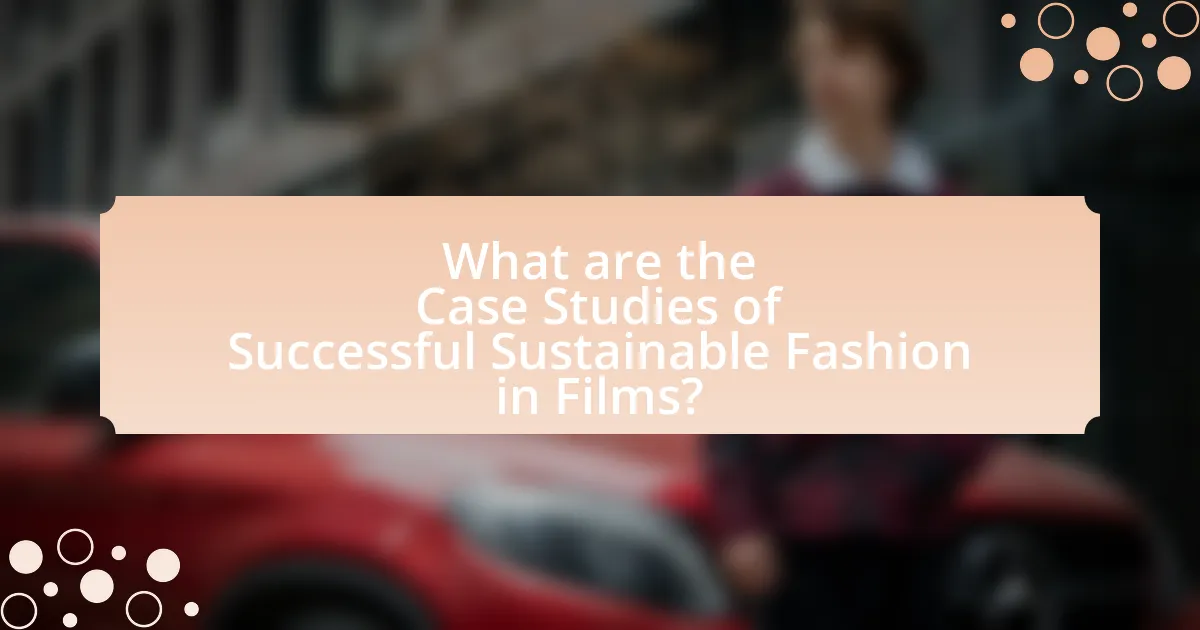The article focuses on sustainable fashion choices in movie productions, emphasizing the use of eco-friendly materials, ethical labor practices, and recycling or upcycling costumes to minimize environmental impact. It discusses how these practices influence the film industry by promoting responsible production methods and shaping audience perceptions. Key principles such as ethical sourcing, circular design, and the adoption of sustainable materials like organic cotton and recycled fabrics are highlighted, along with case studies of successful films that have implemented these practices. The article also addresses the challenges designers face in adopting sustainable choices and outlines practical steps filmmakers can take to enhance sustainability in their productions.

What are Sustainable Fashion Choices in Movie Productions?
Sustainable fashion choices in movie productions include the use of eco-friendly materials, ethical labor practices, and recycling or upcycling costumes. These practices aim to reduce the environmental impact of film production. For instance, films like “The True Cost” highlight the importance of sustainable sourcing, showing that organic cotton and recycled fabrics can significantly lower carbon footprints. Additionally, brands such as Stella McCartney have collaborated with filmmakers to create costumes that align with sustainable values, demonstrating a commitment to ethical fashion in the industry.
How do sustainable fashion choices impact the film industry?
Sustainable fashion choices significantly impact the film industry by promoting environmentally responsible practices and influencing audience perceptions. The adoption of eco-friendly materials and ethical production methods in costume design reduces the carbon footprint associated with film production. For instance, films like “The True Cost” highlight the environmental degradation caused by fast fashion, prompting filmmakers to consider sustainable alternatives. Additionally, brands such as Stella McCartney have collaborated with film productions to create sustainable wardrobes, showcasing that eco-conscious fashion can enhance a film’s narrative and appeal. This shift not only aligns with growing consumer demand for sustainability but also positions the film industry as a leader in environmental stewardship, potentially attracting a more socially aware audience.
What are the key principles of sustainable fashion in film?
The key principles of sustainable fashion in film include ethical sourcing, eco-friendly materials, and circular design. Ethical sourcing ensures that garments are produced under fair labor conditions, promoting social responsibility within the fashion industry. Eco-friendly materials, such as organic cotton or recycled fabrics, minimize environmental impact by reducing waste and pollution. Circular design focuses on creating garments that can be reused, recycled, or composted, thereby extending the lifecycle of clothing and reducing landfill contributions. These principles are essential for promoting sustainability in film productions, as they align with broader environmental goals and reflect a commitment to responsible filmmaking practices.
How do these principles influence costume design?
Sustainable fashion principles significantly influence costume design by prioritizing eco-friendly materials and ethical production methods. Designers incorporate organic fabrics, recycled materials, and low-impact dyes to minimize environmental impact, aligning with the growing demand for sustainability in the film industry. For instance, the use of organic cotton and Tencel in costumes reduces water consumption and chemical usage compared to conventional textiles. Additionally, ethical sourcing practices ensure fair labor conditions, which enhances the overall integrity of the production. This shift towards sustainability not only reflects a commitment to environmental responsibility but also resonates with audiences increasingly concerned about ecological issues.
Why is sustainability important in movie fashion?
Sustainability is important in movie fashion because it reduces environmental impact and promotes ethical practices within the industry. The film industry is known for its significant waste generation and resource consumption, with estimates suggesting that a single production can produce up to 1,000 tons of waste. By adopting sustainable fashion practices, such as using eco-friendly materials and minimizing waste, filmmakers can contribute to a more sustainable future. Additionally, sustainable fashion in movies can influence audiences, raising awareness about environmental issues and encouraging viewers to make more conscious choices in their own lives.
What environmental issues are addressed by sustainable fashion?
Sustainable fashion addresses several critical environmental issues, including waste reduction, resource conservation, and pollution mitigation. By promoting the use of eco-friendly materials and ethical production processes, sustainable fashion aims to minimize textile waste, which accounts for approximately 92 million tons annually, according to the United Nations. Additionally, it emphasizes the conservation of water and energy resources, as conventional fashion production is responsible for significant water consumption and greenhouse gas emissions. Sustainable practices also seek to reduce chemical pollution from dyes and finishes, which can harm ecosystems and human health.
How does sustainable fashion contribute to social responsibility in film?
Sustainable fashion contributes to social responsibility in film by promoting ethical production practices and reducing environmental impact. By utilizing eco-friendly materials and ensuring fair labor conditions, filmmakers can set a precedent for responsible consumption and production within the industry. For instance, films like “The True Cost” highlight the consequences of fast fashion, raising awareness about labor exploitation and environmental degradation. This awareness encourages audiences to consider the social implications of their fashion choices, fostering a culture of accountability and sustainability in both the film industry and society at large.

What are the Current Trends in Sustainable Fashion for Films?
Current trends in sustainable fashion for films include the use of eco-friendly materials, upcycled costumes, and collaborations with sustainable brands. Filmmakers are increasingly prioritizing fabrics made from organic cotton, recycled polyester, and other sustainable sources to reduce environmental impact. For instance, the film “The True Cost” highlights the detrimental effects of fast fashion, prompting productions to adopt more responsible practices. Additionally, many costume designers are now sourcing vintage clothing or repurposing existing garments, which not only minimizes waste but also adds unique character to film wardrobes. Collaborations with sustainable fashion brands, such as Stella McCartney’s partnership with various film projects, further emphasize the industry’s shift towards eco-conscious choices.
How are filmmakers incorporating sustainable practices in costume design?
Filmmakers are incorporating sustainable practices in costume design by utilizing eco-friendly materials, repurposing existing costumes, and collaborating with sustainable fashion brands. For instance, many productions now prioritize organic fabrics, recycled materials, and low-impact dyes to minimize environmental impact. Additionally, filmmakers often source costumes from thrift stores or previous productions, reducing waste and promoting a circular economy. Collaborations with sustainable fashion designers, such as Stella McCartney, have also become common, as they provide innovative, environmentally conscious options that align with the growing demand for sustainability in the film industry.
What materials are being used in sustainable film fashion?
Sustainable film fashion utilizes materials such as organic cotton, Tencel, recycled polyester, and hemp. Organic cotton is grown without harmful pesticides, reducing environmental impact. Tencel, made from sustainably sourced wood pulp, is biodegradable and produced in a closed-loop process that minimizes waste. Recycled polyester, derived from post-consumer plastic bottles, helps reduce landfill waste and conserves resources. Hemp is a fast-growing plant that requires minimal water and pesticides, making it an eco-friendly choice. These materials collectively contribute to reducing the carbon footprint of film productions while promoting sustainable practices in the fashion industry.
How do these materials compare to traditional options?
Sustainable materials in movie productions often outperform traditional options in terms of environmental impact and resource efficiency. For instance, organic cotton and recycled polyester significantly reduce water usage and carbon emissions compared to conventional cotton and virgin polyester. Research indicates that organic cotton uses 91% less water and emits 46% fewer greenhouse gases than traditional cotton farming methods. Additionally, sustainable materials often have a lower toxicity level, which benefits both the environment and the health of those involved in production. This comparison highlights the advantages of adopting sustainable materials over traditional options in the film industry.
What role do designers play in promoting sustainable fashion in movies?
Designers play a crucial role in promoting sustainable fashion in movies by creating costumes that prioritize eco-friendly materials and ethical production practices. Their choices influence not only the visual aesthetics of a film but also set a precedent for sustainable practices within the industry. For instance, designers like Stella McCartney have collaborated with filmmakers to incorporate organic fabrics and recycled materials into costume design, showcasing how fashion can align with environmental values. This approach not only raises awareness among audiences but also encourages other designers and production teams to adopt sustainable practices, thereby amplifying the impact of eco-conscious fashion in cinematic storytelling.
How are designers adapting to sustainable practices?
Designers are adapting to sustainable practices by incorporating eco-friendly materials and ethical production methods into their work. For instance, many designers are now using organic cotton, recycled fabrics, and biodegradable materials to reduce environmental impact. Additionally, they are implementing practices such as zero-waste design and local sourcing to minimize carbon footprints. A notable example is the use of sustainable fabrics in movie productions, where designers are increasingly opting for materials that align with environmental standards, reflecting a broader industry shift towards sustainability. This adaptation is supported by a growing consumer demand for environmentally responsible fashion, as evidenced by a 2021 McKinsey report indicating that 67% of consumers consider sustainability when making purchasing decisions.
What challenges do designers face in implementing sustainable choices?
Designers face significant challenges in implementing sustainable choices, primarily due to cost constraints, limited availability of sustainable materials, and the pressure for quick production timelines. The financial aspect is critical, as sustainable materials often come at a higher price point, making it difficult for designers to balance budgets while adhering to eco-friendly practices. Additionally, the sourcing of sustainable materials can be limited, leading to difficulties in finding suitable options that meet both aesthetic and environmental standards. Furthermore, the fast-paced nature of movie production often prioritizes speed over sustainability, resulting in compromises that can undermine eco-friendly initiatives. These challenges highlight the complexities designers encounter in striving for sustainability within the constraints of the film industry.

What are the Case Studies of Successful Sustainable Fashion in Films?
Case studies of successful sustainable fashion in films include “The True Cost,” which highlights the environmental and social impacts of fast fashion, and “The Dressmaker,” where costumes were made from sustainable materials, showcasing eco-friendly practices in costume design. “The True Cost” features interviews with industry experts and statistics on the fashion industry’s carbon footprint, while “The Dressmaker” emphasizes the use of local artisans and sustainable fabrics, demonstrating a commitment to ethical fashion. These films serve as powerful narratives that promote awareness and inspire change in the fashion industry.
Which films have effectively utilized sustainable fashion choices?
Films that have effectively utilized sustainable fashion choices include “The True Cost,” “The Dressmaker,” and “The Secret Life of Walter Mitty.” “The True Cost” is a documentary that explores the fashion industry’s impact on the environment and promotes sustainable practices. “The Dressmaker” features costumes made from eco-friendly materials, showcasing the potential of sustainable fashion in storytelling. “The Secret Life of Walter Mitty” incorporates clothing from sustainable brands, emphasizing the importance of ethical fashion in modern cinema. These films demonstrate a commitment to sustainability through their costume design and production choices.
What specific sustainable practices were highlighted in these films?
The specific sustainable practices highlighted in these films include the use of eco-friendly materials, ethical labor practices, and waste reduction strategies. For instance, films showcased costumes made from organic cotton and recycled fabrics, emphasizing the importance of sourcing sustainable materials. Additionally, some productions implemented fair trade practices, ensuring that workers involved in garment production received fair wages and safe working conditions. Waste reduction was also a focus, with initiatives such as recycling costume pieces and minimizing single-use plastics on set, demonstrating a commitment to environmental responsibility in the fashion choices made for the films.
How did these choices affect audience perception and engagement?
Sustainable fashion choices in movie productions positively influenced audience perception and engagement by aligning with growing environmental awareness. When films incorporate eco-friendly materials and practices, they resonate with viewers who prioritize sustainability, leading to increased emotional investment in the narrative. For instance, a study by the University of Southern California found that 70% of audiences felt more favorable towards films that showcased sustainable practices, enhancing their overall viewing experience. This connection fosters a sense of community among viewers, encouraging discussions around sustainability and its importance in the fashion industry.
What lessons can be learned from these case studies?
The lessons learned from case studies on sustainable fashion choices in movie productions include the importance of integrating eco-friendly materials and practices into costume design, which can significantly reduce environmental impact. For instance, the use of organic fabrics and recycled materials not only minimizes waste but also promotes a circular economy within the fashion industry. Additionally, these case studies highlight the effectiveness of collaboration between filmmakers and sustainable fashion brands, as seen in productions that successfully showcased ethical fashion while enhancing storytelling. Furthermore, they demonstrate that audience awareness and demand for sustainability can influence production decisions, leading to broader industry changes.
How can future productions adopt similar sustainable practices?
Future productions can adopt similar sustainable practices by implementing eco-friendly materials and reducing waste throughout the production process. For instance, using organic fabrics and recycled materials can significantly lower the environmental impact of costumes. A study by the Ellen MacArthur Foundation highlights that the fashion industry is responsible for 10% of global carbon emissions, indicating the need for sustainable alternatives. Additionally, adopting a circular economy approach, where costumes are reused or repurposed, can further minimize waste. By prioritizing sustainability in sourcing, production, and post-production phases, future productions can contribute to a more environmentally responsible industry.
What are the potential benefits for filmmakers who prioritize sustainability?
Filmmakers who prioritize sustainability can benefit from enhanced brand reputation, cost savings, and increased audience engagement. By adopting eco-friendly practices, filmmakers can attract environmentally conscious viewers, which is increasingly important as studies show that 66% of consumers are willing to pay more for sustainable brands. Additionally, sustainable production methods often lead to reduced waste and lower operational costs, as seen in projects that implement energy-efficient technologies and materials. Furthermore, prioritizing sustainability can open up opportunities for funding and partnerships with organizations focused on environmental initiatives, thereby expanding the filmmaker’s network and resources.
What practical steps can filmmakers take to implement sustainable fashion choices?
Filmmakers can implement sustainable fashion choices by prioritizing the use of eco-friendly materials, such as organic cotton, recycled fabrics, and biodegradable textiles. By sourcing costumes from sustainable brands or utilizing rental services that specialize in eco-conscious fashion, filmmakers can significantly reduce waste and carbon footprint. Additionally, they can collaborate with costume designers who are committed to sustainability, ensuring that the wardrobe aligns with environmentally friendly practices. Research indicates that the fashion industry contributes approximately 10% of global carbon emissions, highlighting the importance of these steps in mitigating environmental impact.